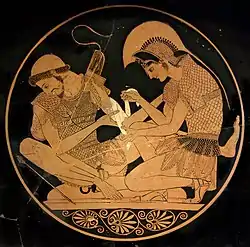Linothorax
The linothorax (pronounced /ˈliːnoʊθɔːræks/; from Ancient Greek: λινοθώραξ Ancient Greek: [linotʰɔ̌ːraːks]) is a type of upper body armor used throughout the ancient Mediterranean world. The term linothorax is a modern term based on the Greek λινοθώραξ, which means "wearing a breastplate of linen";[1] however, the actual ancient term for this type of armor is unclear. The term thorax[2] was the word for breastplate during this era and was traditionally made of metal in most contexts. The linothorax were made of linen glued in layers with animal fat, and eventually adopted by many armies.

The linothorax appears to have been used in place of the bronze cuirass as the popular choice of armor for Greek hoplites, starting perhaps around the late seventh century and early sixth century B.C. This could have been due to the lower price, lesser weight, and cooler material. Its high point in vase paintings, sculptural reliefs and artistic depictions corresponds with the time of the Persian Wars. By the time of the Peloponnesian War it was still used, and continued to seemingly flourish well into the Hellenistic period.
History

The linothorax was used by many nations around the Mediterranean.
The most known users of this style of chest plate was the army of Alexander the Great during the Hellenistic era. Such a light, cool material used for the armor would allow the Macedonians to keep cool in the hot, arid climates of Asia Minor.
When recreated and tested by the University of Wisconsin-Green Bay, the linothorax was resistant to broad-head arrows and slashing damage of weapons with sharp edges. The bend of the fabric would allow the energy of the arrows to dissipate through the material and protect the user from lacerations, and arrows that struck at an angle would often deflect to penetrate a space between different layers of linen, rather than penetrating the linen itself. Blunt force trauma would still transfer through the armor, however, and possibly damage the internal organs of the soldier. This design would be very effective against the standard weapons of the Asia Minor armies: swords, spears, and light axes.
Macedonian hypaspists were equipped with spolas (Greek: σπολάς),[4] which was linothorax with lighter design. The use of the spolas lightened a hoplite's load, in comparison to the standard metal thorax/cuirass.
Depictions

University of Wisconsin Green Bay Professor Gregory S. Aldrete states that there are 27 descriptions by 18 different ancient authors describing the armor, as well as many visual depictions.[3]
The earliest attested account of a linothorax used for battle is recorded in Book 2 of Homer's Iliad (2.529 and 2.830). It is worn by Ajax the Lesser and is described in brief. Homer composed stories long before the armies of Athens, Thebes, Sparta and Macedon understood what the armor was. However, the extent to which it was used can not be fully determined as the texts were not accurate accounts of specific time periods.
It was used by the armies of Alexander the Great, and its mention by other sources such as Herodotus (2.182, 3.47, 7.63), Livy (4.19.2–20.7), Strabo (Geography, 3.3.6, 13.1.10), and many other minor sources.
Very few details of the linothorax's construction are found in Homer and other authors of this era. The linen fabric was reinforced by a metal sheet around the waist, usually in a scale mail style, over a leather or felt cloth called zoma (ζῶμα) (Il. 23.683, 4.216, Od.14.482). Metal plates or flaps called pteryges (πτέρυγες) were protecting various parts of the body (Xenophon, Anabasis 4.7.15). A "zoster" (ζωστήρ)[5] was a belt, probably of leather with metal plates, worn around the waist over the other parts of the cuirass (Il. 4.132, 135,186 etc.).[6] The actual method of constructing a linothorax is unknown as no example has survived from ancient times. The only piece of armor that resembles the linothorax was discovered in a tomb in Vergina, Northern Greece (the ancient Macedonian capital of Aegae). This armor, which was most probably worn for ceremony, was constructed from sheet iron with gold embellishments. It is probably an iron copy of a linothorax.
Since visual evidence is limited to vase paintings and sculptural reliefs, rather than actual surviving models, modern scholars can only guess at its makeup and design. Artistic depictions show armor that has a top piece which covers the shoulders and is tied down on the chest, a main body piece wrapping around the wearer and covering the entire torso, and a row of pteruges or flaps around the bottom which cover the groin and upper thigh. There are a number of vase paintings that show what appear to be metal scales covering the armor.
Research
Modern researchers have had difficulty studying linothorax armor due to it being constructed of biodegradable materials which leave few remains for archeologists to discover.[7]
Gregory S. Aldrete has attempted to reconstruct linothorax armor based on ancient depictions and descriptions.[7] In January 2009, Aldrete and his student Scott Bartell presented a paper discussing the protective qualities of the linothorax at the joint American Philological Association/Archaeological Institute of America Convention held in Philadelphia, Pennsylvania. The pair have been researching the linothorax since 2005 and have built a number of copies, using various methods that include lamination and quilting. They believe the armor was constructed out of linen and rabbit glue.[7] The research was carried out by assembling dozens of linen test patches, arranged in a multitude of fashions, using authentic materials, and subjecting them to arrow shots and sword cuts. The testing was carried out in a sort of "worst-case-scenario" at nearly point-blank range, where the angle of archer to armor was perpendicular. In an actual battle both of these factors would have been considerably different, making the performance of the test patches even more remarkable. The tests also concluded that quilted armor offered roughly three quarters of the protection of laminated armor; thus the quilted patches were less effective. This was found to be true in every sort of test conducted. The research conducted by Aldrete and Bartell was also presented at the 2010 Poster Session for the Archaeological Institute of America (AIA) in Anaheim, California, where it won first prize among many contenders from around the world. The research was published in 2013.[8] On November 9, 2011, Aldrete was featured on an episode of Penn & Teller Tell a Lie, broadcast on the Discovery Channel, where he showed how the linothorax worked by shooting an arrow at Bartell.
See also
References
- λινοθώραξ. Liddell, Henry George; Scott, Robert; A Greek–English Lexicon at the Perseus Project.
- θώραξ in Liddell and Scott.
- "Laminated Linen Protected Alexander the Great : Discovery News". 2010-01-11. Archived from the original on 2010-01-29. Retrieved 2019-11-04.
- σπολάς. Liddell, Henry George; Scott, Robert; A Greek–English Lexicon at the Perseus Project
- ζωστήρ in Liddell and Scott.
- "Autenrieth G. A Homeric Dictionary, article "Θώρηξ" (Thorex)". Archived from the original on 2012-10-16. Retrieved 2011-04-14.
- "Why did Greek warriors go to war wearing what today looks like a linen mini-dress?". Public Radio International. Retrieved 2019-11-03.
- Gregory S. Aldrete; Scott Bartell; Alicia Aldrete (2013). Ancient linen body armor : unraveling the linothorax mystery. Baltimore: Johns Hopkins University Press. ISBN 9781421408194.